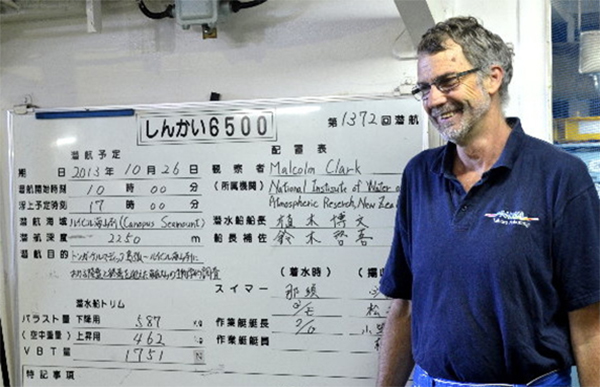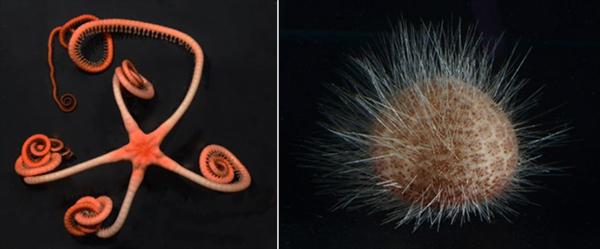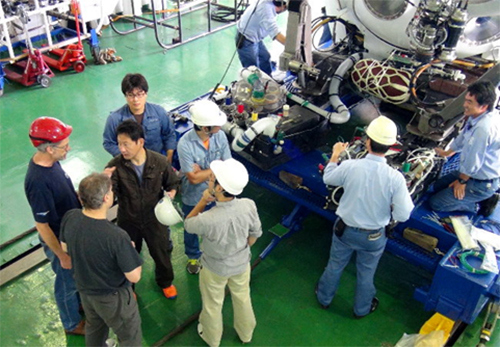QUELLEレポート
10月26日、ルイビル海山列のカノパス海山への潜航を実施!
2013/10/26
Malcolm Clark(National Institute of Water & Atmospheric Research)
天気は朝から快晴。絶好の潜航日より。この航海での最初の潜航者はNIWA(ニュージーランド水大気研究所)のマルコム・クラーク博士(Dr. Malcolm Clark)です。潜航前の博士は、普段通りと変わらず、とてもにこやかでした(写真1)。
博士は、海山における希少な生物や人間の産業活動が海山の生態系に与える影響などを幅広く研究されています。今回は世界で初めてルイビル海山列に潜航した博士に、その印象などをインタビューしました。
○ 潜航を通じて、カノパス海山の深海について、ご専門から見てどのような印象を持たれましたか?
Dr. Malcolm Clark:This is the first time the seamount has been surveyed with an emphasis on biology. Hence, everything was new. The seafloor at depths of about 2000m mainly comprised large flows of pillow lava, with some massive rock walls. Here the dominant faunal species were corals and sponges which were attached to the exposed rock. Many were species that I could recognize from other surveys in New Zealand, but a number were unusual. These included a large slender sponge that was over 2 m long, and a bright orange “tulip” sponge. The species changed as the dive got shallower, with sea fans and golden corals becoming more frequent at about 1200m. The information from the video camera and samples will be an excellent start for comparing with material from New Zealand seamounts to determine how biodiversity may differ on the Louisville seamounts.
この海山における生物学的な調査は初めてであり、どんな観察をしても新発見となります。約2千メートルの深海底は大きな枕状の溶岩が流れたようになっており、ときには巨大な岩の壁で行く手を阻まれます。多く見られる生物は、岩に固着しているサンゴや海綿の仲間でした。それらは、これまでに知られているものもありましたが、見たことがないものもありました。中には、2mを超える大きな細長い海綿や鮮やかなオレンジ色をした”チューリップ”の形をした海綿もみられました。生物の種類は深度とともに変化して約1200mのところでは、イソバナや八放サンゴの仲間が多く登場しました。今回撮影したビデオ映像や採集したサンプルの情報をニュージーランドの他の海山と比較することにより、ルイビル海山列において独自に進化した生物多様性を明らかにするための幸先のよいスタートになりました。
○ 深海の環境から資料を採取する際にはどんなことに気をつけねばなりませんか?
Dr. Malcolm Clark:Normally, deep-sea animals are collected by trawl nets or dredge/sledge equipment. Delicate or fragile animals are often badly damaged in these catches, especially when rocks are also sampled and mixed in with the animals. During this dive, we were able to sample delicate animals such as sea pens and urchins by sucking them up in a pump-operated “slurp gun”. This meant they came to the surface in excellent condition. Other animals and rocks were selectively collected in the manipulator arm. Smaller animals (often too small for the naked eye to see) that live in the top few cm of the sediment were collected in push-cores. The quality of all the specimens collected was exceptional.
普通は、深海から試料を採集するには、トロールネットやドレッジを使います。繊細で壊れやすい動物は、しばしばこれらの中でひどく傷つけられてしまいます。特に、岩石も動物と一緒に採集されるときはなおさらです。今回の潜航では、イソバナの仲間やウニのような繊細な動物を、「スラープガン」という機械を使って採集することができました。そのため、とてもよい状態で引き上げられました。動物と岩石は、マニピュレータを使って分けて採集されました。海底に堆積した数センチの表層に住んでいる、通常は小さすぎて肉眼では見えない動物も柱状採泥器という装置で集められました。今回採集されたものはみな、これまでに類を見ないほどとてもよい状態でした。
○ 今回、博士自ら潜られたわけですが、実際の人の目で深海を見ることの意義について教えて下さい。
Dr. Malcolm Clark:The submersible has a number of important attributes when sampling in the deep-sea. The seafloor can be very rugged on seamounts, and impossible to sample with conventional nets which are too easily ripped and damaged. Also, some habitats can be sensitive, such as around hydrothermal vents where specialist animals thrive in the warm and chemical-rich waters. The submersible is able to move around and avoid unnecessary damage to such environments, sample just what is required for scientific study, as well as sample in rough places. The observer and pilots are also able to direct operations and alter plans based on what they actually see at the time, thereby maximising the value of each dive. The human eye actually seeing everything in 3-D gives a much better understanding of how the deep-sea environment is structured than simply watching a TV screen.
深海でサンプリングを行うために、この潜水船はいくつもの重要な役割を果たしてくれます。海山の海底は起伏に富み、これまでのようにネットを使うわけにはいきません。とくに、暖かく化学成分に富む熱水噴出孔周辺には、特殊な生物が生息し、その環境はとても繊細です。「しんかい6500」は、そのような環境でも自由に動き回ることができ、不必要なダメージを与えず、研究に必要な分の試料だけ採集をすることが可能です。観察する科学者とパイロットは、直接観察しながら操作しているので、リアルタイムで計画を決定することもできます。つまり各潜航を最大限活かせるわけです。人間の眼は三次元にものを見ることで、単にTV画面を見るのに比べて、どのように深海の環境が成り立っているかを理解するのにはるかに優れています。
○ 「しんかい6500」の乗り心地は如何でしたか?
Dr. Malcolm Clark:This was my first dive in Shinkai 6500. Previously I have dived in shallower-rated submersibles. That is, of course, a major advantage for this survey, in that it goes deeper than many other submersibles or remotely-operated vehicles. Originally we were intending to dive to 3000m, and even though we have started dives a bit shallower, there has been no concern about the robustness of the Shinkai to handle extreme pressures at depth. The range of sampling capabilities that Shinkai has, is also very impressive.
はじめて「しんかい6500」に乗りました。これまでは、深度の低い潜水船の経験しかありませんでした。「しんかい6500」でより深い海に潜れることが、他の潜水船やROVにはない大きな利点であることは、言うまでもありません。もともとは、深度3000mに潜航しようとしていました。実際には、ほんの少し浅くなりました。もちろん高圧に耐えられる強靭な「しんかい6500」への心配はありません。さらに「しんかい6500」の高いサンプリング能力も驚くべきものがあります。
○ 日本とニュージーランドの協力について、一言お願いします。
Dr. Malcolm Clark:Japan and New Zealand have very strong science links. Both countries share similar marine issues, with being part of the western Pacific “Ring of Fire” (where there is a plate boundary and many volcanoes stretching from New Zealand up to Japan). There has been a wide range of joint research voyages, and scientific collaboration between colleagues from data collection, through analysis, to publication. This is highlighted by Quelle2013 where a multidisciplinary team from both countries has joined forces, which maximises the benefits of using the high level of Japanese technology with the Shinkai 6500. New Zealand does not have such technology, and so it is important for New Zealand scientists to develop such partnerships. We hope these will continue well into the future.
日本とニュージーランドは、科学においてとても強いつながりがあります。両国は、太平洋の"リング・オブ・ファイア"(プレート境界であり、多くの火山がニュージーランドから日本までつながっています)の一部分として、同じような海洋問題をかかえています。多分野にわたる共同研究航海や、データ採集、分析、公開と研究者間の協力が行われています。両国からの幅広い分野のチームが力を合わせ、「しんかい6500」のもつ日本の高い技術を最大限に活用したプロジェクト「QUELLE2013」はそのハイライトとも言えるものです。そのような技術を持たないニュージーランドの科学者にとって、協力は重要であり、今後とも素晴らしい関係が続くことを希望します。
Thank you very much! Dr. Clark. お疲れ様でした。ありがとうございました。

写真1 「しんかい6500」の1372回目の潜航に望むマルコム・クラーク博士

写真2 YK13-11 1372潜航で採集したクモヒトデの仲間(左)とウニ類の一種(右)

写真3 潜航直前、土田首席研究員らと打合せを行うクラーク博士